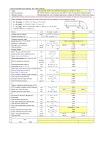
BACKGROUND
Polyvinyl chloride (PVC) was discovered in the late nineteenth century. Scientists at that time found the new plastic material unusual in that it appeared nearly inert to most chemicals. However, it was soon discovered that the material was resistant to change, and it was concluded that the material could not be easily formed or processed into usable applications.
In the 1920s, scientific curiosity again brought polyvinyl chloride to public attention. In Europe and America, extended efforts eventually brought PVC plastics to the modern world. Technology, worldwide and particularly in Germany, slowly evolved for the use of PVC in its unplasticized, rigid form, which today is used in the production of a great many extruded and molded products. In the mid-1930s, German scientists and engineers developed and produced limited quantities of PVC pipe. Some PVC pipe installed at that time continues to provide satisfactory service today. Molecularly oriented polyvinyl chloride (PVCO) pressure pipe has been installed in Europe since the early 1970s and in North America since 1991 .
INTRODUCTION
This document has been developed by the Uni-Bell PVC Pipe Association for use as a field installation guide.
General information regarding the correct installation of gasketed-joint solid-wall PVC sewer pipe is included.
Relevant product standards are:
- ASTM D3034 “Standard Specification for Type PSM Poly (Vinyl Chloride) (PVC) Sewer Pipe and Fittings”
- ASTM F679 “Standard Specification for Poly (Vinyl Chloride) (PVC) Large-Diameter Plastic Gravity Sewer Pipe and Fittings”
For more detailed technical information and for information on profile-wall PVC pipes, consult the pipe
manufacturer or refer to ASTM D2321, “Standard Practice for Underground Installation of Thermoplastic Pipe for Sewers and Other Gravity-Flow Applications..” The Handbook of PVC Pipe: Design and Construction provides additional guidance on PVC pipe design and installation. For information on this publication, please contact Uni- Bell.
The Uni-Bell PVC Pipe Association, formed in 1971, funds PVC pipe research and development, provides technical service and support, develops recommended standards, and promotes proper use of PVC pipe with gasketed joints. Uni-Bell members are manufacturers who are dedicated to producing high quality PVC pipe products for the industry.
The statements contained in this installation guide are those of the Uni-Bell PVC Pipe Association and are not warranties, nor are they intended to be warranties. Inquiries for information on specific products, their attributes and recommended uses, and the manufacturer’s warranty should be directed to member companies.









-page-001.jpg)


0 Comments